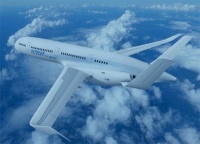Aeroplanes made of transparent materials so passengers can have unparalleled views as they fly above the pyramids or Eiffel Tower could be a reality by 2050.
This is only part of the wacky and slightly frightening vision of what flights could be like in 40 years according to engineers at Airbus.
Their ideas were outlined in a report titled ‘The Future, by Airbus’ released by the aerospace giant this week.
Possibly the most eye-catching concept was the potential for aeroplanes constructed with controllable opaque or transparent walls, negating the need for windows.
The report states: ‘This smarter structure would help to make the aircraft lighter and more cost-efficient while giving the passenger 360 degree views of the skies. The planes of the future will offer an unparalleled, unobstructed view of the wonders of the five continents – where you will be able see the pyramids or the Eiffel Tower through the transparent floor of the aircraft.’
Airbus’ engineers also think they have a solution for increasing the flight distances of small aeroplanes. According to the report, ‘We could have flying aircraft carriers for our long distance flights, which circle the globe and on which small aircraft can dock.’
As far as improving flight experience, forget free peanuts and in-flight movies, Airbus reckons holographic technology will be the way to keep passengers content. It says: ‘Perhaps you would prefer a private cabin… that can turn into an office… or a bedroom… or a zen garden? Or anything else you like, thanks to the projection of virtual decors. Holographic technology will have advanced to such a degree that the virtual world will be indistinguishable from the real.
‘So imagine, if you will, stepping in to your pre-selected themed cabin, relaxing into a perfectly clean, ecologically grown seat that changes shape to suit you and looking up through the transparent ceiling at the Milky Way in all its glory, at an altitude of 10,000 metres.’

Perhaps the least sensational of all Airbus’ crystal-ball gazing is its predictions for new energy sources. It guesses the ‘Cryoplane’, fuelled by hydrogen, is a potential aircraft of the future.
While it is known that aircraft can fly with hydrogen, Airbus says the problem today’s engineers face is that it is too voluminous, and above all, does not exist on earth in a pure form, so a lot of energy would have to be wasted to produce it. It points out that fuel cells that use hydrogen and oxygen from the air to make electricity, would not work for an aircraft. However, because they are quieter and non-polluting, they may replace batteries and power generators in the future.
Airbus noted, ‘In the long term hydrogen may not be the solution, but nuclear fusion, or perhaps superconductivity, could give us limitless environmentally friendly energy production.’
The report also looked at solar power, noting the triumph of the Solar Impulse aircraft, but said there are limitations:‘The question that leaves engineers scratching their heads now, is how to make that leap from the light aircraft we’ve seen make a major technological breakthrough today, to fuelling the passenger airliners of tomorrow?
‘If an entire aircraft were to be covered with 100 per cent efficient solar panels, it would still not be enough to sufficiently propel a large aircraft. Even greatly increasing the output of photovoltaic cells wouldn’t make an airliner fly. In the more immediate future solar power could provide electricity on board the aircraft once it has reached altitude.’
The company also revealed its plans for future use of biofuels in aviation. It stated a belief that biomass could provide up to 30 per cent of all commercial aviation jet fuel by 2030.
Even passengers could help power aircraft. Airbus envisions harvesting energy from the body heat passengers give their seat or bed in the cabin.
All of this of course assumes we will actually be flying on aeroplanes in the future. After all, 2050 is decades from now and, who knows, we may finally get that long-promised jetpack.
Click here to read the report.




AI-generated medical responses need monitoring, study finds
This would negate most of the benefit of using AI in the first place, rather like the Locomotive Act 1865 that required any self-propelled road...